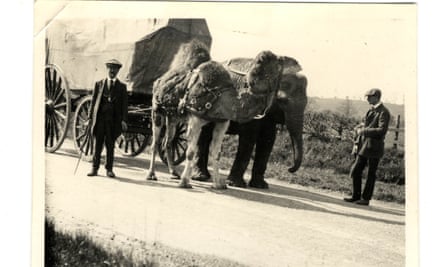They are more used to excavating prehistoric, Roman and Anglo-Saxon sites, but archaeologists are now embarking on an extraordinary hunt for the fabled burial site of a 19th-century elephant – in south Gloucestershire.
This was a famous “beast” that drew crowds as part of a travelling menagerie that toured the length and breadth of Britain. It is thought to be the mighty mammal identified as Nancy in contemporary reports, which praised her “considerable intelligence” and ability to achieve “many astonishing feats”. According to local legend, she died in 1891 after escaping and chewing on poisonous yew leaves, and she was buried somewhere in the town of Kingswood.
Lorrain Higbee, a specialist in animal bones with Wessex Archaeology, which has been commissioned to conduct a geophysical survey, told the Observer: “I’ve been doing this job for over 30 years and this is the first time that somebody has said ‘we’re going on an elephant hunt’. We occasionally get bits of mammoth come up from our coastal and marine dredging projects. They’re the older ancestors of elephants, but I never expected to have the possibility of finding the burial of a menagerie elephant in Britain. It’s exciting.”
Her colleague at Wessex Archaeology Tom Richardson, a terrestrial geophysicist, said: “Searching for Victorian elephant burials isn’t our usual fare, but a grave of that size would leave a large hole and would certainly be identifiable with the ground-penetrating radar equipment we will be using.”
Menageries featuring exotic animals were hugely popular entertainment throughout the Victorian era and early 20th century. Some boasted hundreds of animals, obtained at vast expense from dealers who had agents in big port cities such as Liverpool.
The Kingswood elephant was part of Bostock and Wombwell’s Menagerie, which, as the Bristol Mercury reported in 1891, would “take up its quarters” for eight days on the open space near Lawrence Hill station, not far from Kingswood.

Its readers were told: “Among the larger animals in the collection is Nancy, a fine nine-year-old elephant, four camels, ten or a dozen fine lions and lionesses, three Bengal tigers, a sacred Indian bull … some leopards, polar and brown bears, a hyena, and a pack of Russian wolves … The animals are all in splendid condition.”
Wessex Archaeology is a leading archaeology and heritage organisation and educational charity, working with planners, designers and developers. The elephant hunt has been commissioned by South Gloucestershire council as part of a regeneration project for Kingswood and surrounding areas – a £25m investment that includes a part-pedestrianisation scheme.
Dr Steve Ward, a circus historian and author, described the search as “an exciting quest to explore local history”, adding: “It would be nice to confirm the local legend.”
He continued: “During the 19th century, the fascination with the natural world allowed both travelling and static menageries to flourish. Seeing these creatures was seen as educational – indeed the government actively encouraged families to take their children. But merely viewing them was not enough; the public also wanted to be entertained. In some menageries, animal keepers began to perform tricks with their beasts, especially with the large carnivores and elephants.”

He said that people now would probably be horrified at the way some animals were treated in the 19th century: “But, within the context of the period, certainly many were kept as well as they could be. Many of the animals kept in captivity by menagerie owners were relatively well-kept simply because it was their bread and butter. An elephant could cost many hundreds of pounds, and to lose one was a big blow.
after newsletter promotion
“There are records – particularly in reference to elephants – of the keepers tending to their every need, and even sleeping with them to keep them company,” Ward said.
Higbee, who is Wessex Archaeology’s principal zooarchaeologist, said that, if the Kingswood elephant could be found and excavated, its remains could offer new insights: “You may be surprised at what we could learn about the life of this animal. As well as understanding where it came from and its age, we may be able to see the impact of its life as an entertainer. This may include evidence of confinement, such as trauma from shackling the animal.
“It may also be possible to detect injuries or strains resulting from its performance duties, such as repetitive movements that they wouldn’t naturally do if they weren’t captive.”
Last year, a 19th-century crocodile was found under a school classroom in Rhondda in Wales, during renovation work. Until then, the story of a buried creature was assumed to be a myth.
Ward said of the Kingswood elephant: “Even if they don’t find it, the legend will live on.”
Join the exciting world of cryptocurrency trading with ByBit! As a new trader, you can benefit from a $10 bonus and up to $1,000 in rewards when you register using our referral link. With ByBit’s user-friendly platform and advanced trading tools, you can take advantage of cryptocurrency volatility and potentially make significant profits. Don’t miss this opportunity – sign up now and start trading!







Recent Comments